Bulletin – September 2017 Financial Stability Shadow Bank Lending to the Residential Property Market
- Download 436KB
Abstract
Shadow bank lending can play an important role in the economy, but on a large enough scale it could damage financial system resilience. Domestic banks have tightened standards for lending to the residential property market over recent years, creating an opportunity for other lenders to expand. However, shadow banks appear to account for only a small share of total property loans in Australia. Their share of lending for property development has increased more than for housing lending.
Shadow Banking
Shadow bank financing is similar to bank lending, but typically more risky. The Financial Stability Board (FSB) defines shadow bank lending as credit intermediated outside of the regulated banking sector. Shadow bank lending can play an important role in supporting economic activity by broadening access to credit for parts of the economy that have difficulties accessing bank loans. It can also foster competition between lenders and distribute risk away from systemically important parts of the financial system. Like traditional banking, shadow bank activities typically involve maturity or liquidity transformation and the use of leverage.[1] However, a fundamental difference is that shadow banks operate with less prudential oversight. This can lead shadow banks to adopt much riskier business models. Shadow bank lending can also pose threats to the stability of the financial system if the additional credit amplifies or propagates pre-existing financial system vulnerabilities. This is especially problematic if competitive pressures from the shadow bank sector encourage banks to loosen lending criteria, or if shadow banks create an avenue for borrowing that circumvents prudential regulation.
Many of these attributes of shadow bank lending were present in the lead-up to the financial crisis in the United States in 2008. Securitisation of poor quality assets, maturity transformation by entities without access to central bank liquidity and excessive leverage by non-prudentially regulated broker-dealers all exacerbated underlying vulnerabilities in the US housing market and financial system.[2] In response, an important element of the international regulatory agenda since the global financial crisis has been to steer shadow banks towards more resilient market-based structures (FSB 2014).
Shadow bank activity in Australia has followed a similar pattern to that in other countries, expanding rapidly until 2008 and then falling sharply over subsequent years (Graph 1). As a share of the financial system, shadow bank lending is estimated to have declined from 15 per cent in 2007 to around 7 per cent currently. The shadow banking sector in Australia is (and always was) small by international standards (Graph 2).[3] It also has only limited interconnections with the prudentially regulated sector (RBA 2017).
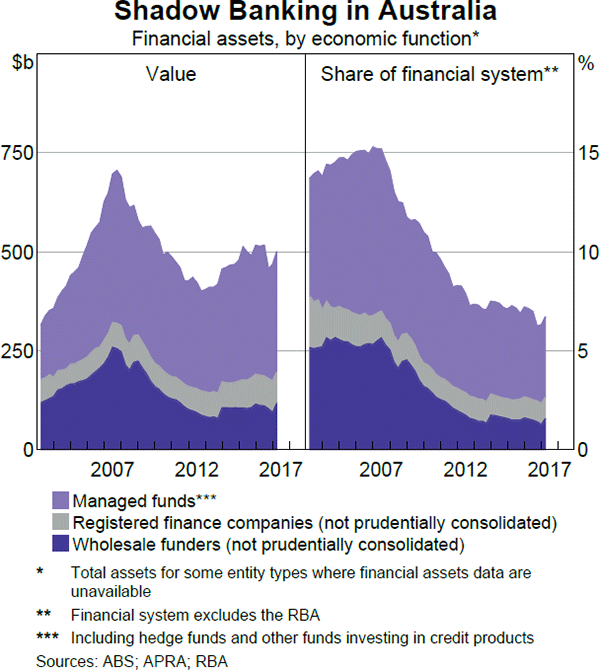
The Australian shadow banking sector can be separated into three main types of entities:
- Managed funds (including hedge funds and other funds investing in credit products): these tend to be equity financed by wealthy individuals, syndicates, trusts and superannuation funds. They account for about two-thirds of Australia's shadow banking sector. Their share has increased a little over the past decade as financial assets have expanded.
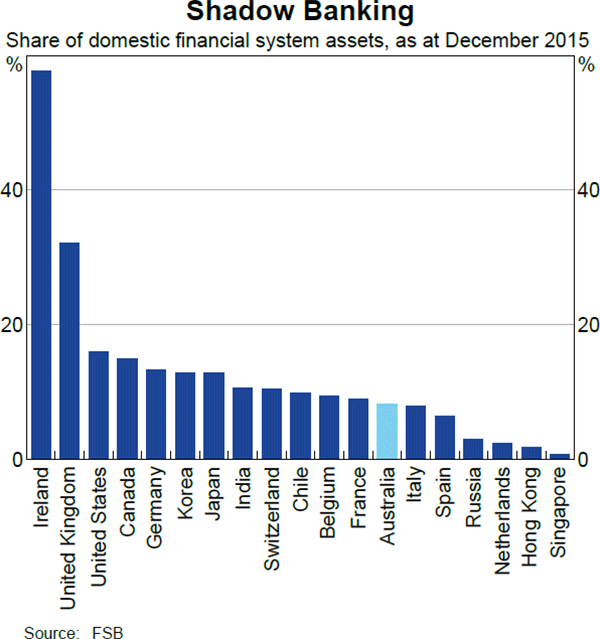
- Registered Financial Corporations (RFCs): these entities' principal business is to intermediate debt finance, in the same manner as a bank but without access to deposit funding. They account for around one-sixth of the domestic shadow banking system.[4]
- Wholesale funders: these are securitisation vehicles that are not consolidated within a banking group. They primarily originate residential mortgages and rely heavily on securitisation to fund their activities. They account for one-fifth of the shadow banking system, down from one-third prior to the crisis.
A tightening in regulation of the banking sector has historically contributed to growth of shadow banking. Cizel et al (2016) show that macroprudential policies aimed at slowing bank credit growth have typically resulted in lending by banks contracting but lending by non-banks growing. This substitution effect has been found to be stronger in countries where there is a greater reliance on lending from the largest banks (Morris-Levenson, Sarama and Ungerer 2017). Indeed, more onerous capital requirements for banks compared with non-banks were one factor underpinning the rapid growth in global securitisation markets in the mid 2000s. More recently, Kim, Plosser and Santos (2016) show that the US Federal Reserve's guidance to banks to curtail leveraged lending to businesses saw non-banks increase their market share. And in some European countries, most notably the Netherlands, stricter capital requirements for banks have contributed to the notable rise over the past six years in the share of outstanding mortgage credit originated by pension funds and insurers (ECB 2017).[5]
This international experience is instructive given the recent tightening in lending conditions for property in Australia. Most notably, the ability of authorised deposit-taking institutions (ADIs) to originate some types of residential mortgages has been constrained by the Australian Prudential Regulation Authority's (APRA) guidance since the end of 2014 promoting sound lending practices. This has included a benchmark for growth in investor lending, tighter lending standards and recently announced limits on interest-only lending (APRA 2014; APRA 2017). In addition, ADIs have chosen to reduce their lending to borrowers relying on foreign income, prompted by some cases of fraud. Banks have also reduced their appetite for property development lending following a reassessment of the associated risk, in part prompted by supervisory attention.
Shadow Bank Property Lending
Shadow banking seemingly only accounts for a small share of property lending in Australia, but it is still important to monitor given the potential for it to grow rapidly and influence banks' lending standards. The following sections examine whether shadow banks have increased their share of mortgage origination and lending for property development.
Accurately assessing the scale of shadow bank property lending is difficult because non-prudentially regulated entities are subject to less extensive reporting requirements than ADIs are. RFCs are required to supply only a very small subset of the information APRA collects from banks, and APRA specifies only voluntary reporting arrangements on wholesale funders and no requirements on managed funds. There are various reasons why these requirements are more limited. First, reporting RFCs must be a corporation, meaning that alternative structures (most notably, trusts) that intermediate credit in much the same way are not captured. Second, RFCs are only required to report their activities to APRA if lending accounts for at least 50 per cent of their total assets in Australia and they are predominantly financed by debt; some corporations with a sufficiently large non-lending asset base or that are equity financed are therefore exempt, despite their lending activities being material. Finally, RFCs must self-identify to APRA; some entities might choose not to identify themselves to avoid the reporting burden, while others might be unaware of their reporting obligations. In recognition of this (and other) limitations, this years' Federal Budget proposed to expand the scope of the Financial Sector (Collection of Data) 2001 Act.
Lending to the residential mortgage market
Estimates suggest that shadow banks' share of housing credit is small, having fallen in the years after the crisis.
One set of estimates are based on RFC and wholesale funds data collected by APRA and periodic surveys conducted by the Reserve Bank of Australia for the purpose of calculating the monthly financial aggregates (Graph 3).[6] The decline in these estimates was driven by the sharp contraction in residential mortgage-backed securities (RMBS) markets following the global financial crisis; RMBS were used to fund shadow banks' residential mortgage lending. Shadow banks' share of housing credit increased a little over 2015 and 2016 as APRA communicated tighter expectations for ADIs' lending standards and there was some improvement in the RMBS market. However, shadow banks' share of the market has not grown much over the past year, despite further tightening in constraints on banks' lending.
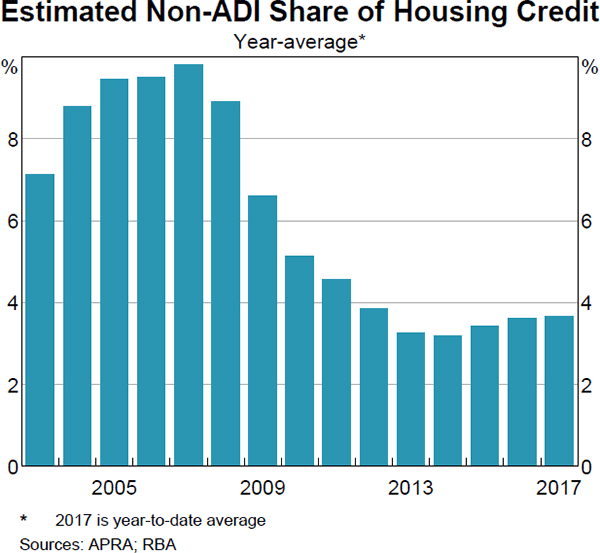
Alternative data sources confirm the slight pick-up in shadow bank housing credit in recent years. RMBS are the main liability used by shadow banks to fund housing credit. Adding the stock of RMBS issued by shadow banks to an estimate of shadow banks' warehouse loans from large banks indicates that shadow banks account for around 2 per cent of total housing credit.[7] This estimate may understate the true figure as it only captures those securities that are eligible for repurchase with the Reserve Bank and does not measure any warehouse finance that could be provided by other financial institutions. Public issuance of RMBS by shadow banks fell sharply after the financial crisis and has remained at a low level, as has been the case in other advanced economies where little or no direct government support is offered to the RMBS market (Graph 4).[8] However, issuance has been stronger in the past year than any other 12-month period since the crisis, with only some portion of this increase reflecting entities reducing their stock of warehoused loans as conditions in the domestic RMBS market have improved (RBA 2017).
Another potential trigger for shadow banks to expand residential mortgage lending has been the major banks' withdrawal from lending to borrowers who rely on non-resident income. Foreign banks with close ties to the borrowers' home country (enabling them to more readily verify the supporting documentation) appear to be the main entities expanding in response, rather than shadow banks. However, there have been reports of managed funds and RFCs providing finance to these borrowers, sometimes funded by international private equity and at times facilitated by property sales agents. Some property developers with larger balance sheets have also been offering a form of bridging (or ‘vendor’) finance to customers unable to obtain bank finance in order to ensure settlement occurs. This shadow bank activity has increased of late, but appears to still be a tiny portion of total housing credit. More generally, it is unlikely that the scale of shadow bank lending to non-residents is large, since such lending has never been a significant part of banks' businesses.
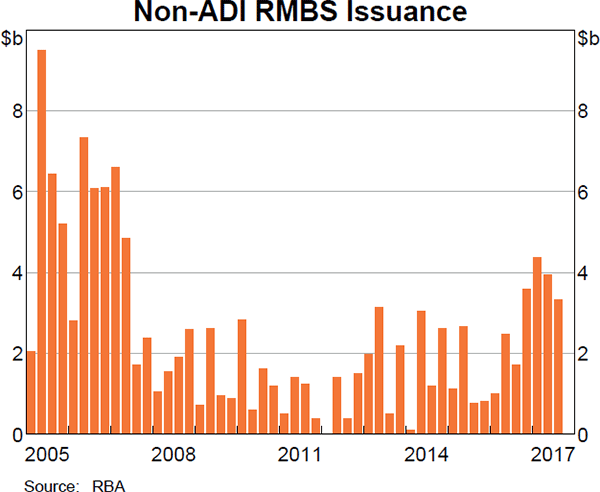
Lending for property development
Assessing shadow bank lending for property development, rather than mortgages, is even more challenging. Entities lending to this sector do not require the visibility needed to sell residential mortgages to households. Australian law also provides less protection for commercial borrowers compared with consumers because they are thought to be more informed and financially sophisticated borrowers.[9] It therefore attracts less regulatory oversight compared with residential mortgage lending. The nature of such lending – large loans to a small number of developers – also means that lending is typically arranged bilaterally rather than through a centralised distribution network of brokers that exists for housing lending.
The way that property development is typically financed also complicates the assessment of credit provision by shadow banks. Historically, developers have commonly funded a moderate-to-large portion of a project with bank loans, while some have supplemented this with additional finance from shadow banks, such as mezzanine debt or equity.[10] Many of the shadow bank financiers have a long association with property development in Australia. These financiers can be funded by (or invest on behalf of ) a single wealthy individual or a pool of investors, typically comprised of family trusts, individuals, superannuation funds, other property developers and construction firms.
Available data, although incomplete, suggests there has been a pick-up in shadow bank lending to property developers. One partial source is RFC data collected by APRA, which indicate that RFCs' share of residential property development loan approvals fell from a pre-crisis level of 14 per cent to zero in 2011, before increasing to a little under 4 per cent in the second half of 2016 (Graph 5). However, RFCs account for only a portion of shadow bank lending to the property development sector and so these data are incomplete. A broader measure comes from Australian Bureau of Statistics data on managed funds' lending to non-financial corporations.[11] This amounts to $28 billion (compared with $225 billion in bank loans to commercial property), and has been little changed since 2014. However, this figure is likely to significantly overstate lending to property development as it includes loans made to corporations for any purpose (that is, both non-property related and to purchase established property).[12]
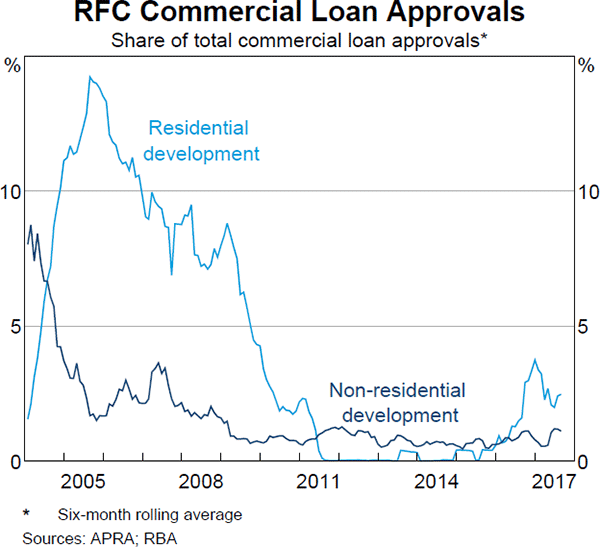
Given the paucity of reliable data, the Reserve Bank's business liaison program provides a useful complement in assessing the growth and nature of shadow bank lending for commercial property. This information suggests that the recent expansion of shadow bank lending for property development is likely greater than suggested by RFC data, but still only partially offsets the pull-back by the major banks. Liaison identifies that some shadow bank lenders that have typically provided higher-risk finance have expanded into offering senior debt that would have historically been provided by a bank. Industry participants have also observed a range of new firms funding property developments, including foreign funds. In addition, some shadow banks have increased the share of project funding they provide as banks have lowered the maximum loan-to-valuation ratio they are willing to offer. The structure of project funding is important as projects in which a bank provides senior debt and a shadow bank provides mezzanine debt will be subject to a level of prudential oversight (as banks approve the credit extension with visibility of the mezzanine debt), unlike deals in which there is no bank involved.
Information on the structure of shadow bank lending arrangements is limited, but deal characteristics appear to vary widely. Shadow bank lenders charge higher interest rates for senior debt than banks, although some lending conditions, such as minimum apartment pre-sale requirements or caps on pre-sales to foreign buyers, can be somewhat more relaxed than those currently imposed by banks. For mezzanine debt, interest rates are reported to be around 15 per cent or higher, and have increased alongside demand from developers as banks have sought to limit their exposure to property development. Property developers in the Bank's liaison program report that there has been an overall tightening in financing conditions despite the expansion of shadow bank lenders, with a higher average cost of funds and reduced availability for developers. Project feasibility has become more difficult to achieve, and higher equity contributions are generally needed.
Constraints to Growth
While shadow bank lending to the domestic property market is estimated to be small, it is important to understand whether these activities can grow rapidly and how they could feed back to bank lending for property.
For residential mortgage lending, a key constraint is the cost and availability of warehouse financing, which is generally provided by a major bank. Data collected by APRA reveals that shadow banks currently have access to about $16 billion in warehouse facilities from large banks, of which $11 billion was drawn as at June 2017. Both estimates are lower than last year, perhaps partly reflecting the decline in shadow banks' inventory of warehoused loans as conditions in securitisation markets have improved. Revisions to APRA securitisation regulations, which come into effect from January 2018, will increase the cost to banks of providing warehouse financing. Banks' willingness to provide warehouse facilities will also be limited by APRA's March 2017 announcement that it would be concerned if ‘warehouse facilities were growing at a materially faster rate than an ADI's own housing loan portfolio, or if lending standards for loans held within warehouses are of a materially lower quality than would be consistent with industry-wide sound practices’.
A second constraint to shadow bank activity is their more limited funding options. Shadow banks have only limited access to short-term wholesale markets and no access to deposit funding. Securitisation contributed to a build-up of shadow banking risks prior to the crisis but has since become a more expensive source of funding compared to options available to ADIs, such as deposits. This means that shadow banks will only be competitive when lending to borrowers with lower credit quality that typically pay higher interest rates.
Despite these constraints, it is still possible that other sources of capital could emerge to fund shadow banks' activities. Arguably, this is more likely to occur with the global search for yield in the current low interest rate environment. Alternative sources could include the managed funds industry, either locally or internationally. Innovation in financing arrangements, like that in the Netherlands (see above), could be a way to attract more funding from these sources.
Conclusion
Shadow banks' share of lending to the domestic property market has increased as banks' underwriting standards have tightened since the end of 2014. Nonetheless, the available evidence suggests that shadow banks' residential mortgage lending accounts for only a small share of this market and this share is currently not growing by much. In addition, there are several constraints to this lending being quickly scaled up. Shadow banks' lending to property development – while more difficult to measure – appears to have increased relatively strongly over the past year or so, though from a low base and not likely enough to replace the pull-back by large banks. In many cases, this lending still occurs with some regulatory oversight because banks continue to provide senior debt to these developments (though perhaps less than in the past). Moreover, shadow banks providing mezzanine debt tend to demand a premium for this type of lending, in recognition of the greater risks involved.
Data constraints are a challenge in monitoring the size and growth of shadow bank lending to property. Additional data on shadow bank activities are expected to be collected if proposed legislative changes announced in this year's Federal Budget are passed. This would be an important step to enhance the ability to monitor these activities and assess their impact on financial stability.
Footnotes
Michael Gishkariany and David Norman are from Financial Stability Department and Tom Rosewall is from Economic Analysis Department. [*]
See Manalo, McLoughlin and Schwartz (2015) for a broader discussion on the nature of shadow banking, both domestically and internationally. [1]
For a fuller discussion, see, for example, Edey (2009). [2]
The measure of shadow banking presented in this article is consistent with the FSB's narrow measure, which limits other financial intermediaries' (OFI) assets to those relating to lending activities. Focusing on this measure allows for a more targeted assessment of shadow banking risks to financial stability compared with a broader OFI measure, which includes all assets of non-prudentially regulated entities, including those not related to credit intermediation. [3]
Registered finance companies that are consolidated into broader domestic or international banking groups are excluded from this measure. [4]
It is debateable whether this strengthens or weakens financial stability. Pension funds and insurers are regulated entities and in the Netherlands are subject to the same macroprudential rules as banks, but these investors may be less familiar with the risks involved in mortgage lending, are not subject to the same degree of regulation as banks, and may impair the profitability of the banking system (see DNB (2016) and ECB (2017) for a fuller discussion of these issues). [5]
Residential mortgage lending by managed funds (which includes superannuation funds) is estimated to be less than 0.1 per cent of the stock of housing credit, and is excluded. [6]
Securitised housing credit from the Reserve Bank's securitisation database is about $22 billion and warehouse facilities with large banks as estimated by APRA total about $11 billion. Warehouse facilities are temporary lines of credit provided to special purpose vehicles, including shadow banks, as they accumulate enough loans to securitise. [7]
Government assistance in the form of a purchase program from the Australian Office of Financial Management (AOFM) helped support market activity for a period during the crisis. See Debelle (2009) for more information. [8]
Key legislative protection for non-consumer borrowers is in the Australian Securities and Investments Commission Act 2001. This specifies some basic protections for commercial borrowers, such as prohibiting unconscionable, misleading or deceptive conduct. [9]
In a capital structure, mezzanine debt is between senior debt and equity. [10]
These data include superannuation funds and other trust structures. Recent media reports an increase in their lending to property development. [11]
Private equity is another possible source of funding. Available data indicate that total assets for this sector are around $10 billion, but are mostly security investments. [12]
References
APRA (2014), ‘APRA outlines further steps to reinforce sound residential mortgage lending practices’, Media Release No 14.30, 9 December. Available at <http://www.apra.gov.au/MediaReleases/Pages/14_30.aspx>.
APRA (2017), ‘APRA announces further measures to reinforce sound residential mortgage lending practices’, Media Release No 17.11, 31 March. Available at <http://www.apra.gov.au/MediaReleases/Pages/17_11.aspx>.
Cizel J, J Frost, A Houben and P Wierts (2016), ‘Effective Macroprudential Policy: Cross-Sector Substitution from Price and Quantity Measures’ 94.
Debelle G (2009), ‘Whither Securitisation?’, Address to the Australian Securitisation Conference, Sydney, 18 November.
DNB (2016), ‘Emergence of new providers in credit markets beneficial to financial system’ DNBulletin, 29 November. Available at <https://translate.google.com/translate?hl=en&sl=nl&tl=en&u=https%3A%2F%2Fwww.dnb.nl%2Fnieuws%2Fnieuwsoverzicht-en-archief%2Fdnbulletin-2016%2Fdnb349593.jsp>.
ECB (2017), ‘Box 7’, Financial Stability Review, May. Available at <https://www.ecb.europa.eu/pub/pdf/other/ecb.financialstabilityreview201705.en.pdf?60c526239a8ecb2b6a81cfedd898cc0d>.
Edey M (2009), ‘The Financial Crisis and its Effects’, Address to the Foundation for Aged Care Business Breakfast, Sydney, 19 March.
FSB (2014), ‘Transforming Shadow Banking into Resilient Market-based Financing’, 14 November. Available at <http://www.fsb.org/wp-content/uploads/Progress-Report-on-Transforming-Shadow-Banking-into-Resilient-Market-Based-Financing.pdf>.
Kim S, M Plosser and J Santos (2016), ‘Did the Supervisory Guidance on Leveraged Lending Work?’, Liberty Street Economics site, 16 May. Available at <http://libertystreeteconomics.newyorkfed.org/2016/05/did-the-supervisory-guidance-on-leveraged-lending-work.html>.
Manalo J, K McLoughlin and C Schwartz (2015), ‘Shadow Banking – International and Domestic Developments’, RBA Bulletin, March, pp 75–83.
Morris-Levenson J, R Sarama and C Ungerer (2017), ‘Does Tighter Bank Regulation Affect Mortgage Originations?’, SSRN, January, unpublished manuscript. Available at <https://ssrn.com/abstract=2941177>.
RBA (2017), ‘The Australian Financial System’, RBA Financial Stability Review, April, pp 33–44.